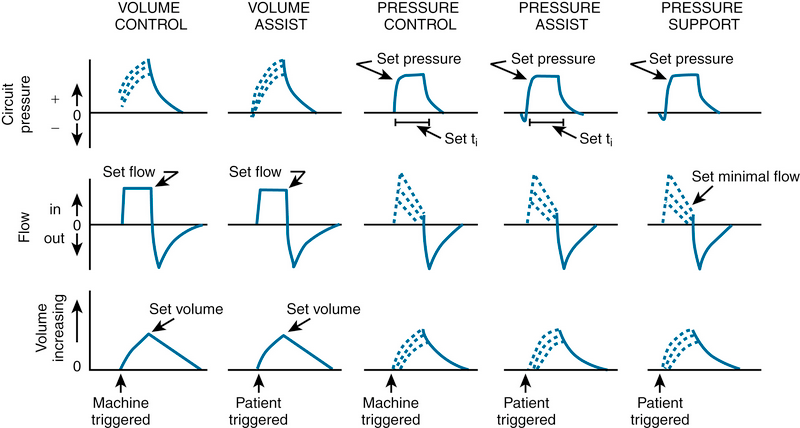basic modes of ventilators
- related: understanding of ventilators
- tags: #permanent #icu
- source: design features of modern mechanical ventilators, Murray and Nadel Ch 135 Mechanical Ventilation
- volume control: machine triggered, flow targeted, volume cycled
- volume assist: patient triggered, flow targeted, volume cycled
- pressure control: machine triggered, pressure targeted, time cycled
- pressure assisted: patient or machine triggered, pressure targeted, flow cycled
- pressure support: patient triggered, pressure targeted, flow cycled
- SIMV, synchronized intermittent mandatory ventilation: minimum controlled breaths with assisted breaths:
- e.g. volume or pressure control, any other breaths will be pressure supported
- PRVC, pressure regulated volume control: pressure targeted.
- However, the tidal volume of previous breath is used as feedback mechanism to change the target pressure. You set the volume. If the delivered volume is too low, machine will increase targeted pressure with next breath and vice versa.
- This is best of both volume and pressure mode. In volume mode, having a set tidal volume can cause barotrauma in patients with very low compliance as result of very high pressure needed to get to that tidal volume. In pressure mode, the tidal volume is unpredictable. Patients with low compliance will have very low tidal volume and decreased ventilation. Patients with high compliance will have too high of tidal volume and volutrauma. PRVC allows an average tidal volume target in pressure mode.
- Down side being if a patient is very anxious, they can have high tidal volume, leading machine to believe they need less pressure support

- we don’t use CMV or IMV anymore
- SIMV is what we normally use
Links to this note
-
reverse triggering is when patient initiates 2nd breath
- related: basic modes of ventilators
-
double triggering is when patient initiates both breaths
- related: basic modes of ventilators
-
flow desynchrony can happen with air hunger
- related: basic modes of ventilators
-
ineffective trigger asynchrony
- related: basic modes of ventilators
-
- related: basic modes of ventilators